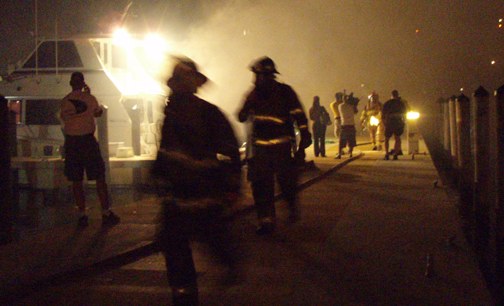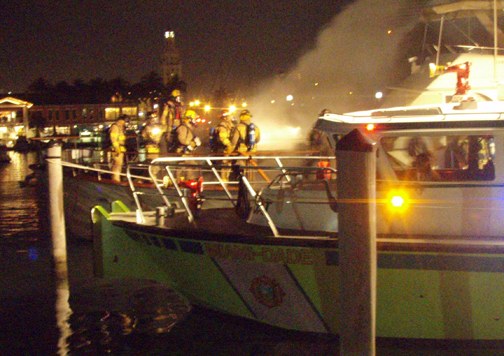
Boat Explodes Next to Wanderlust 3

When Mike Harker finally returned to Miami following both his personal and his Hunter Mariner 49 Wanderlust 3‘s circumnavigations, he had more excitement than during almost any time during the trip.
"I was sitting in Hooters Restaurant having a burger and watching the sights outside the window in the direction of my boat when all of the sudden there was an explosion," he writes. "The flames and a lot of smoke blocked my view of the my boat, so I jumped up as best I could, and got on my folding bike to rush back to my boat. By the time I got there, the Sheriff and six fire trucks were blocking my path, not letting anyone through. When I explained that it was possibly my boat in flames, a sheriff accompanied me to my boat. Fortunately, my boat was all right, but the boat two empty slips down from mine was being broken apart and doused with water! Only later did I learn the full extent of the tragedy: one man died and another was badly injured.

What a welcome back to the States!"
Gitana 13 – Rounds the Horn. . . Finally
After five days of waiting out not one, but two big weather systems, the 110-ft French trimaran Gitana 13 should finally be rounding Cape Horn as you read this. Next stop: San Francisco.
Stopping is not something you generally want to do when going for a sailing record — G-13 is attempting to break the 57-day sailing record from New York to San Francisco. But it was a necessary evil at the mouth of the Lemaire Channel, the ‘doorway to Cape Horn’. That’s where they hove to Monday under bare poles to wait out the two big weather systems in relatively sheltered water. Those two systems, with winds of 55-70 knots, battered not only Tierra del Fuego but, more importantly, Gitana‘s intended course up the west coast of Chile. Once the winds weakened to 25 last evening, they still had to sail close-hauled about 100 miles up the Lemaire Channel and around ol’ Cape Stiff itself. Not much fun on any boat, even a big, strong one like this.
The good news is that about 50 miles past the legendary promontory, the wind is expected to clock around to the east-southeast, which means more good reaching. The 10-man crew hopes to ride this breeze north-northwest all the way to the next low-pressure system. And from there on it should be smooth sailing all the way to the equator. If they transit the doldrums as quickly in the Pacific as they did in the Atlantic, they will still be on schedule to sail under the Golden Gate later this month, which would lower the existing record by a bit more than two weeks. Keep checking ‘Lectronic Latitude for updates or go to www.gitana-team.com/en.
Circumnavigating in a Tin Can
After a test sail on San Francisco Bay on Saturday, 39-year-old David Vann of Tallahassee, Florida, hopes to leave Sunday on a four-month non-stop singlehanded circumnavigation via the Southern Ocean aboard his trimaran Tin Can. Given that Frenchman Francis Joyon recently did the same thing in just 57 days with his 97-ft trimaran IDEC, it sounds like an exciting possibility . . . until you hear the details.
Unlike Joyon, whose IDEC is as modern as she is basic, Vann intends to do his 26,000-mile voyage in the 50-ft aluminum trimaran that he built in a matter of months with a total budget of $25,000. To say that Tin Can is crude in design and construction would be generous, as she’s what a kid’s homemade go-kart is to a Mercedes-Benz. But she’s not as ill-conceived as she could have been. After Vann’s first naval architect quit as a result of having nightmares about the project, his new naval architect, Yves-Marie Tanton, was at least successful in convincing him to heighten the house from two feet to four feet, and then widen it from 18 inches to 30 inches. Yeah, she’s one of those dream boats.
Having had his first boat sink — and written the book A Mile Down about the experience — Vann is championing his tri’s positive flotation as being the magic characteristic. He says that his inspiration for this voyage is Ken Barnes of Southern California, whose attempt at a singlehanded circumnavgation with the Gulfstream 44 Privateer ended when he was dismasted after just 6,500 miles. Vann claims his tri is superior because she can’t sink. We can understand Vann’s desire to never have a boat sink from beneath him again, but positive flotation is not the be all and end all for sailing vessels. Peter Hogg of the Corinthian YC can confirm that. After all, Hogg’s trimaran flipped just outside the Gate during a race many years ago, and was next seen — big parts of her still floating and intact, mind you — on the other side of the Pacific. And Lord knows the Atlantic is littered with the still happily floating debris of many ORMA 60 trimarans.
Several readers have asked us what we think of Vann’s project. We’re mostly indifferent, as we sense too much form and too little content. Vann likens himself to Sir Edmund Hillary, the first man to climb Everest — seemingly forgetting that Hillary made use of the best climbing gear at the time. To continue with that analogy, it’s as though Vann wants to join the club of those who have made it to the top of Everest, but wants to be the first to make it having sewn his own shirt, pants, socks, and having cobbled his own boots — and not having spent more than $25 in the process. The greater wonder is not whether he could do it, but why he would try.
One reason Vann might is money. He’s only had to ante up $25,000, so if he makes it long enough for things to be interesting — and they can’t help but be — there will certainly be fodder for another book. As it is, the blog of his adventure appears “exclusively” on that well-known journal of serious adventurers, Esquire Magazine. Check it out at www.esquire.com/the-side/blog/tincan.
Could Vann make it around the world in four months? No. For one thing, by the time he gets down to the Southern Ocean, the relatively good weather of summer will be over, and the nights will be longer and colder. Vann hedges his bets a little by saying that he doesn’t have a death wish — even while dropping the fact that his father and another extended family member committed suicide — and that he’ll feel free to stop whenever and for however long he feels it necessary for safety.
Given an unlimited amount of time, could Vann make it around the world with Tin Can? It’s certainly possible — assuming that the Coast Guard doesn’t declare it a ‘manifestly unsafe voyage’ and prevent him from leaving. Remember that Glen Tieman of Southern California sailed all the way across the Pacific over a 10-year period in the 26-ft catamaran Peregrine that he built for 1/8th of what Vann has spent on his tri.
The main determinant for Vann will be the weather. If he gets lucky, we think he could make it — but it’s going to take an awful lot of luck given the amount of time he’s going to have to spend in the Southern Ocean. We certainly hope this doesn’t happen, but we suspect there’s a greater chance of Tin Can flipping before getting to Pt. Conception — rendering all the positive flotation in the world meaningless — than getting enough good weather to survive the Southern Ocean. But only time will tell.
Two other critical factors involve strength. Are Tin Can and her gear tough enough, and does Vann have the mental fortitude? Again, only time will tell.
If nothing else, Vann’s project has got us thinking about all the various sailing stunts there have been over the years. We’ve been able to come up with about 20 so far, our favorite being the French guy who, in the early ’90s, cut a wine cask in half, put a keel on the bottom and a mast on the top, and sailed it across the Atlantic. Can you add to our list?
BMW Oracle’s New Training Platform
Anticipating a Deed of Gift challenge against Alinghi for America’s Cup 33, BMW Oracle Racing launched an Extreme 40 catamaran in Valencia on Wednesday as part of their workup to what may be an October series. The new-to-them high-tech Extreme 40 arrived some three weeks after Alinghi took a pair of sisterships for a spin, literally — tacking in front of the Oracle base in Valencia’s harbor. The maneuver was recorded on video and displayed on Alinghi‘s web site, in a less than impressive display of gamesmanship.
The high performance catamaran is the product of a collaboration between Olympic Tornado medallists Australian Mitch Booth and Frenchman Yves Loday, and is one of 11 built to date — originally to provide what proved to be a crowd-pleasing sideshow at the stopovers in the last Volvo Ocean Race. Since then the boats have been sailing in a circuit sponsored by worldwide mutual fund provider iShares that’s taken them around Europe in an eight-event series in 2007. The 40-ft catamarans are a blast to watch as they are capable of speeds approaching 40 knots and spectacular capsizes.
Oracle reportedly has another Extreme 40 on the way for tuning purposes. But that’s not the only new ride on its way to the garage. It’s rumored that they’re expecting delivery of a brand-new TP 52 built to a Reichel-Pugh design for this year’s Med Cup TP 52 circuit. With those three new boats they should have plenty to keep the sailing team busy in the Mediterranean while the legal team continues the dialup in the New York Courts.
